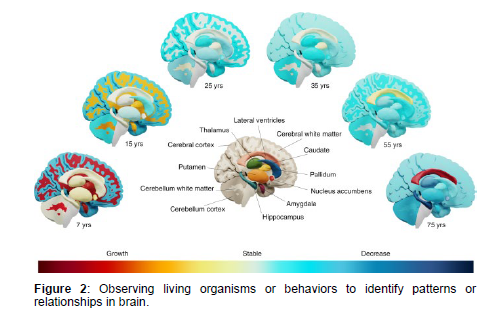A Study Focused on Life Science and Brain Research Information
Received: 30-Mar-2023 / Manuscript No. ijaiti-23-98418 / Editor assigned: 03-Apr-2023 / PreQC No. ijaiti-23-98418 (PQ) / Reviewed: 17-Apr-2023 / QC No. ijaiti-23-98418 / Revised: 22-Apr-2023 / Manuscript No. ijaiti-23-98418(R) / Published Date: 29-Apr-2023
Abstract
Life science and brain research are important and rapidly developing fields of study that seeks to better understand living organisms and the complex functioning of the brain. Life science research encompasses a wide range of disciplines, including genetics, biochemistry, ecology, and evolutionary biology. Brain research is a specialized field that explores the neural mechanisms underlying cognitive processes, brain development, and brain disorders. Both of these fields have produced important results that have impacted human health, agriculture, conservation, and technology. However, ethical considerations must be taken into account, and on-going dialogue is necessary to consider the potential risks and benefits of scientific research. In conclusion, life science and brain research are crucial for improving our understanding of the natural world and advancing human knowledge and technology.
Keywords
Technology; Human knowledge; Brain; Ethical considerations; Genetics
Introduction of Life Science and Brain Research
Life science is a field of study that focuses on the study of living organisms, including their structure, function, behavior, and evolution. It includes a variety of scientific disciplines such as biology, biochemistry, genetics, physiology, ecology, and more [1, 2]. Brain research, also known as neuroscience, is a subfield of life science that focuses specifically on the study of the brain and nervous system. It aims to understand how the brain works, how it processes information, and how it influences behavior and cognition.
Brain research involves the use of a variety of tools and techniques, including neuroimaging, electrophysiology, molecular biology, and behavioural studies. It has led to many important discoveries about the brain and its functions, including the identification of different regions of the brain that are responsible for specific functions such as memory, language, and emotion.
The study of the brain is also important for understanding and treating neurological and psychiatric disorders, such as Alzheimer's disease, Parkinson's disease, and depression. Brain research is a rapidly growing field, and it has the potential to revolutionize our understanding of the brain and its role in human behavior and cognition [3].
What is Life Science and Brain Research?
Life science is the study of living organisms, including their structure, function, behavior, and evolution. It encompasses a wide range of scientific fields such as biology, biochemistry, genetics, physiology, ecology, and more.
Brain research, also known as neuroscience, is a subfield of life science that focuses specifically on the study of the brain and nervous system. It aims to understand how the brain works, how it processes information, and how it influences behavior and cognition.
Brain research involves the use of a variety of tools and techniques, including neuroimaging, electrophysiology, molecular biology, and behavioural studies. It has led to many important discoveries about the brain and its functions, including the identification of different regions of the brain that are responsible for specific functions such as memory, language, and emotion.
The study of the brain is also important for understanding and treating neurological and psychiatric disorders, such as Alzheimer's disease, Parkinson's disease, and depression. Brain research is a rapidly growing field, and it has the potential to revolutionize our understanding of the brain and its role in human behavior and cognition [4, 5].
Methods of Life Science and Brain Research
The methods used in life science and brain research are diverse, and they depend on the specific field of study and the research question being addressed. However, here are some common methods used in these fields (Figure 1).
Observation: Researchers often start by observing living organisms or Behaviors to identify patterns or relationships that can be studied further.
Experimentation: Controlled experiments are often used to test hypotheses or to manipulate variables in a controlled setting [6].
Imaging: Neuroimaging techniques such as functional magnetic resonance imaging (fMRI) and positron emission tomography (PET) are used to visualize brain activity and map brain regions responsible for specific functions.
Electrophysiology: This involves measuring the electrical activity of cells or tissues in the brain, such as the recording of action potentials or the measurement of electroencephalography (EEG) signals.
Molecular biology: Techniques such as PCR, Western Blot, gene cloning and sequencing are used to study the molecular mechanisms underlying biological processes [7].
Behavioural studies: This involves studying the Behaviors of organisms, including humans, to understand how they respond to different stimuli.
Computational modeling: Computational models are used to simulate biological processes or to test hypotheses in silico. These methods are often used in combination to obtain a more comprehensive understanding of biological systems and brain function. Additionally, ethical considerations must be taken into account in the design and implementation of research studies involving living organisms, particularly with human subjects [8].
Types of Life Science and Brain Research
There are many different types of life science and brain research, each with its own focus and methods. Here are some of the major types
Biology: The study of living organisms, including their structure, function, and behavior.
Genetics: The study of genes and heredity, including the mechanisms of inheritance and the role of genes in development and disease [9].
Biochemistry: The study of chemical processes within living organisms, including the metabolism of cells and the function of biomolecules such as proteins, carbohydrates, and lipids.
Ecology: The study of the interactions between organisms and their environment, including the distribution and abundance of different species and the effects of human activities on ecosystems.
Evolutionary biology: The study of the processes that lead to the diversity of life on Earth, including natural selection and adaptation (Figure 2).
Brain Research
Cognitive neuroscience: The study of the neural mechanisms underlying cognitive processes such as perception, attention, memory, language, and decision making.
Developmental neuroscience: The study of the development of the nervous system and its effects on behavior and cognition.
Neuroimaging: The use of imaging techniques such as fMRI and PET to visualize brain activity and map brain regions responsible for specific functions [10].
Neuropsychology: The study of the relationship between brain function and behavior, including the effects of brain damage and disease on cognition and behavior.
Molecular neuroscience: The study of the molecular mechanisms underlying neural function and the development of drugs for neurological and psychiatric disorders.
These are just a few examples of the types of life science and brain research that are being conducted today. The field is constantly evolving, and new areas of research are emerging all the time.
Result
Life science and brain research have produced many important results that have significantly impacted our understanding of living organisms and the brain. Here are some examples:
Understanding of diseases: Life science research has led to a better understanding of the mechanisms underlying diseases, such as cancer, Alzheimer's disease, Parkinson's disease, and many others. This understanding has led to the development of new drugs and therapies to treat these diseases.
Advances in genetics: Life science research has led to the identification of genes responsible for many inherited diseases and has enabled the development of new genetic therapies.
Agriculture and food production: Life science research has led to advances in agriculture and food production, including the development of genetically modified crops, which are more resistant to pests and disease and have increased yields.
Conservation and biodiversity: Life science research has led to a better understanding of the natural world and has contributed to the preservation of biodiversity and the protection of endangered species.
Understanding of brain function: Brain research has led to a better understanding of the mechanisms underlying brain function, including the identification of different brain regions responsible for specific functions such as memory, language, and emotion. This understanding has led to the development of new treatments for neurological and psychiatric disorders.
Development of technologies: Brain research has led to the development of new technologies such as brain-machine interfaces, which enable people to control prosthetic limbs or other devices with their thoughts.
These are just a few examples of the many important results that have been achieved through life science and brain research. The ongoing work in these fields holds great promise for improving human health and understanding the natural world [7-10].
Conclusion
In conclusion, life science and brain research are vital fields of study that have significantly advanced our understanding of living organisms and the brain. These fields encompass a wide range of disciplines, from genetics and biochemistry to cognitive neuroscience and neuroimaging. The results of research in these fields have led to important advances in human health, agriculture, conservation, and technology.
However, as with all scientific research, ethical considerations must be taken into account. Researchers must ensure that their work is conducted in a responsible and ethical manner, with the welfare of living organisms and human subjects being of the utmost importance. It is also important to acknowledge that scientific research is a continuous process, and new discoveries and technologies may bring both benefits and potential risks. It is therefore important to carefully consider the implications of scientific research and to engage in ongoing dialogue about its impact on society.
References
- Abubakar I (2022) What Netflix’s high profile flop in Nigeria says about Africa’s content markets 8.
- Aggarwal N, Arthofer F, Lind F, Rose J, Rosenzweig J, et al. (2016) The digital revolution is disrupting the TV industry.
- Ayogu GO (2021) Being a paper presented at the maiden edition of the Nigeria Union of Journalists (NUJ), ICT Correspondents Lecture Series titled: Digital Streaming Technologies: Challenges and Prospects held at the Banquet Hall, Sheraton Hotels, Abuja, Nigeria.
- Camilleri MA, Falzon L (2020) Understanding motivations to use online.
- Danbatta U (2022) Nigeria telephone subscribers now 195 million-NCC Godwin Isenyo Punch Newspaper.
- Kamer L (2022) Subscribers of Netflix and Multi choice Show max in Africa 2021.
- Krejcie RV, Morgan DW (1970) Determining sample size for research activities. Educ Psychol Meas 30:607-610.
- Lee CC, Nagpal P, Ruane SG, Lim HS (2018) Factor affecting online streaming subscriptions. Commun IIMA 16:125-140.
- Maniar N J (2020) Streaming Media in Seel N M (eds) Encyclopedia of the Sciences of Learning.
- Atakiti I O (2017) Internet penetration and the adoption of Television streaming among stakeholders in South-West, Nigeria. Being an unpublished Ph.D. thesis submitted to the Mass Commun, Babcock University.
Indexed at, Google Scholar, Crossref
Citation: Hussain T (2023) A Study Focused on Life Science and Brain Research Information. Int J Adv Innovat Thoughts Ideas, 12: 208.
Copyright: © 2023 Hussain T. This is an open-access article distributed under the terms of the Creative Commons Attribution License, which permits unrestricted use, distribution, and reproduction in any medium, provided the original author and source are credited.
Select your language of interest to view the total content in your interested language
Share This Article
Recommended Journals
Open Access Journals
Article Usage
- Total views: 1680
- [From(publication date): 0-2023 - Nov 18, 2025]
- Breakdown by view type
- HTML page views: 1341
- PDF downloads: 339


